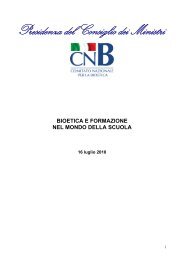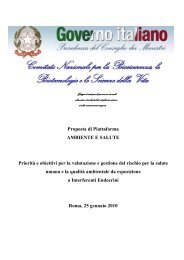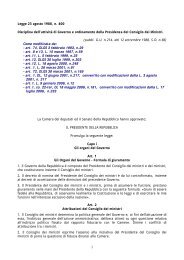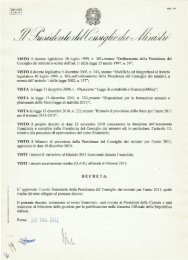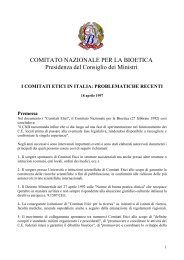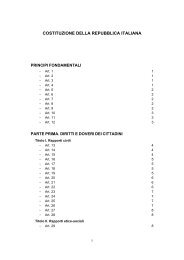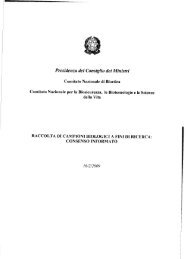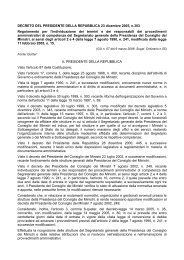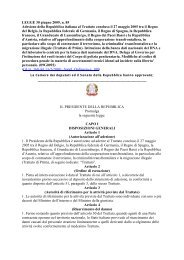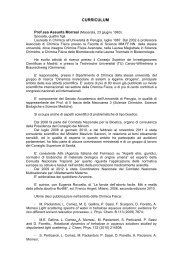President
President
President
You also want an ePaper? Increase the reach of your titles
YUMPU automatically turns print PDFs into web optimized ePapers that Google loves.
The document “Interspecies embryos” of the English Medical Academy,<br />
which is in favour of the creation of this type of hybrid embryos, states: “in the<br />
context of cytoplasmic hybrid embryos, mitochondria and cytoplasm represent<br />
potential retrovirus sources within the animal oocyte. […] The nuclear genome<br />
of cows and rabbits contains the endogen retroviral genome. It is therefore<br />
possible that the cytoplasm of rabbit or bovine oocytes can contain transcripts<br />
(of RNA) or express endogen retrovirus codified by their nuclear genome.<br />
These viruses could reintegrate in the transferred human nucleus. This<br />
occurrence must be considered highly improbable but not impossible”. The<br />
same document suggests the preventive assessment of the existence of<br />
“expression profiles of endogen retroviruses” (that is, the expression of any<br />
retrovirus) before using the oocytes, and it stresses that, for the same reasons,<br />
stem cell lines so produced could not in any case be used for clinical<br />
treatments. The English Medical Academy also stated that in standard<br />
conditions of safety there would be no problem 51 . Different hearings – written<br />
and oral – given by the Science and Technology Committee 52 highlighted the<br />
same problem, so that the potential use of these cells for in vitro studies<br />
emerged, but not for in vivo experimentation.<br />
Some NBC members 53 stress that the eventual clinical application of stem<br />
cells derived from hybrids (as with any other type of stem cell) on human<br />
beings, will have to undergo the provisions contained in the recent “Regulation<br />
(EC) Number 1394/2007 of the European Parliament and of the Council on<br />
Advanced therapy medicinal product”. Looking out for problems regarding<br />
biosecurity involves, therefore, the eventual clinical application of the products,<br />
which will not be allowed until the procedures to obtain these products (and the<br />
products themselves) are not shown to be free from risks to human health.<br />
According to the same NBC members, all this has nothing to do with the<br />
experiments as long as they are confined to the laboratory or are used as an<br />
instrument to investigate specific biological issues.<br />
Bioethical evaluations<br />
NBC members 54 started from two different types of ethical considerations:<br />
I. some concern the evaluation of scientific research and of the reasons<br />
given to defend its practicability;<br />
II. others refer, instead, to the issue of the identity of man and of the<br />
human species.<br />
suggested by the federal Food and Drug Administration (FDA).” (Hfea, Scientific and Clinic<br />
Advanced Group, Mitochondria and Development, 16.7.2005).<br />
51<br />
Inter Species Embryos, A report by Academy of Medical Science, June 2007, in<br />
http://www.acmedsci.ac.uk/p47prid51.html<br />
52<br />
Science and Technology Committee, UK Parliament, Fifth Report of session 2006/07;<br />
Government proposal for the regulation of hybrid and chimera embryos, 5.4.2007, in<br />
http://www.parliament.uk/parliamentary_committees/science_and_technology_committee/scien<br />
ce_and_technology_committee_reports_and_publications.cfm<br />
53<br />
C. Flamigni, S. Garattini, D. Neri, A. Piazza, M. Toraldo di Francia, G. Zuffa.<br />
54<br />
S. Amato, A. Bompiani, R. Colombo, A. Da Re, F. D’Agostino, B. Dallapiccola, M.L. Di Pietro,<br />
M. Gensabella, A. Isidori, A. Morresi, L.Palazzani, V.Possenti, L.Proietti, L.Scaraffia;<br />
A.Nicolussi adheres to the ethical reasons sub II, 1,2,3.<br />
26




